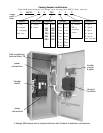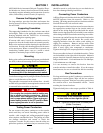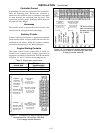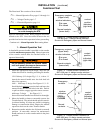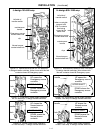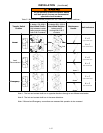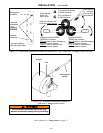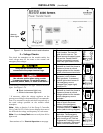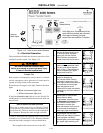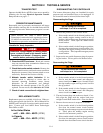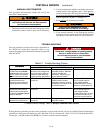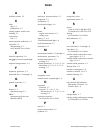
SECTION 1 INSTALLATION
1 --- 1
ASCO 4000SeriesAutomatic Delayed–TransitionTrans-
fer Switches are factory wired and tested. Field i nstalla-
tion simply requires mounting and connection of service
cables, and auxiliary control circuits (if required).
Remove the Shipping Skid
For large swit ches, open the front door and remove the
four lagscrews (2infront, 2in rear)securing enclosureto
the wood skid.
Supporting Foundation
The supporting foundation for the enclosure must level
and straight. Refer to the applicable enclosure outline
drawing included with the 4ADTS for all mounting
details including door opening space.
If bottom cable entry is used, the foundation must be
prepared so that the conduit stubs are located correctly.
Refer to the enclosure outline drawing for specified area
and location. Provide cable bendingspace and clearance
to live metal parts. When a concrete floor is poured, use
interlocking conduit spacer caps or a wood or metal
template to maintain proper conduit alignment.
Mounting
Referto the outline andmountingdiagram providedwith
the ATS; it shows all mounting details and instructions.
Protect the switch from construction grit
and metal chips to prevent malfunction or
shortened life of the automatic switch switch.
Mount the ATS vertically to a rigid supporting structure.
L evelallmountingpointsbyusingf lat washersbehindthe
holes to avoi d distortion of the switch.
The controller is mounted on the cabinet door. An add-
onDIN raili s provided forsome optionalaccessoriesand
is mounted below controller on the door.
De–energize the conductors before making any
line or auxiliary circuitry connections. Be sure
that Normal and Emergency line connections
are in proper phase rotation. Place engine gen-
erator starting control in the OFF position. Make
sure engine generator is not in operation.
Testing Power Conductors
Do not connect the power conductors to the transfer
switch until they are tested. Installing power cables in
conduit, cable troughs and ceiling-suspended hangers
often requires considerable force. The pulling of cables
can damage insulation and stretch or break the
conductor’s strands. For this reason, after the cables are
pulled into position, and before they are connected, they
should be tested to verify that they are not defective or
have been damaged during installation.
Connecting Power Conductors
AWiring Diagramisfurnishedwith theASCO 4000Series
4ADTS (separate from this manual). Refer to this
drawing. All wiringmust be made in accordance with the
National Electrical Code and local codes.
Afterthepowercableshave beentested, connect themto
the appropriate terminal lugs on the transfer switch as
shown on the wiring diagram provided with the switch.
Make sure the lugs provided are suitable for use with the
cables being installed. Standard terminal lugs are solder-
lessscrewtypeandwillacceptthewiresizeslistedonthe
drawings provided with the switch. Be careful when
stripping insulation from the cables; avoid nicking or
ringing the conductor. Remove surface oxides from
cables by cleaning with a wire brush. When aluminum
cable is used, apply joint compound to conductors.
Tighten cable lugs to the torque specified on rating label.
Donotruncablesin frontof orbehindthe switch. Cables
can be bundled on the right side of the switch. Maintain
proper electrical clearance between the live metal parts
and grounded metal: ½ i nch minimumfor 150-400 amps,
1 inch minimum over 400 amps.
It is not necessary to remove the barriers from the
transfer switches to install the cables. If you do remove
them,however, be sure to reinstall the barriers carefully.
Bus Connections
Forlargeswitchesuse grade 5hardware to connect busto
appropriate terminal plates. Wipe off the bus surfaces
beforetheyare joined. Ifthe busis verydirty, gentlyclean
the surfaces with a non---flammable solvent. Avoid
touching the cleaned surfaces.
Tighten bolted joints to the torque specified in Table A.
The reliability of the connection depends
on how clean and how tight the joint is.
Table A. Tightening torque values for bolted joints
(Grade 5 hardware)
Bol t Diameter
in inches
Tightening Torque
in foot pounds
1/4 7
5/16 12
3/8 20
1/2 50
5/8 95
3/4 155




